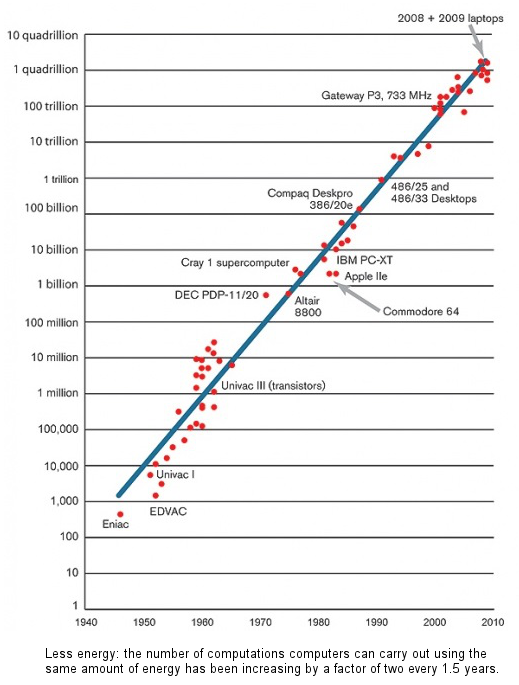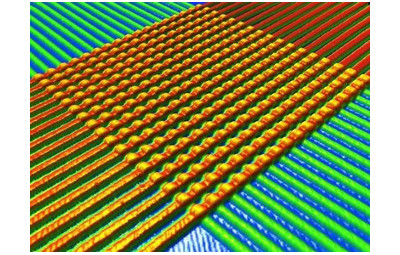
2.3. Current technology trends
On April 9, 2012 Jonathan Koomey in Technology Review has shown an interesting analysis of computational energy efficiency. He observed that
- The number of computations computers can carry out using the same amount of energy has been increasing by a factor of two every 1.5 years.
- Computing isn’t just getting cheaper. It’s becoming more energy efficient. That means that a world populated by ubiquitous sensors and streams of nanodata is possible.

Fig. 2.3/1: Computations (per KWh), source
Koomey's law
The Koomey's law may be written in the compact form as follows: \[N=C \cdot 2^{{T} \over {1.5}}\] where \(N\) is the number of computetions per \(kWh\), \(T\) is a time expressed in years and \(C\) is a constant, which can be estimated from the above picture. From the formula, we deduce that the energetic cost of one computation is the following function of time \[c(T)=D \cdot 2^{−{{T} \over {1.5}}}\]
From this equation we deduce that by about 2050 (so, perhaps sooner), nearly all computing will be heat-limited, as bit energies approach the absolute thermodynamic Landauer limit, where only one bit's worth of physical information (physical entropy) is used to encode each logical bit. Reversible computing is a necessity in order to further increase a system's rate of computation per unit power consumed beyond the point where that limit has been reached.
Since 1945, computers follow the “Von Neumann” architecture. It consists of a control unit, arithmetic processors, memory and input/output devices. Some special processors have been created with other architectures, but all our general-purpose computers have been following this.
It seems that in the coming years we can expect a technological breakthrough in energy efficient computing. Huwett-Packard Company promises that by 2016 will produce a new generation of computers. Their code name is T-Machine. The main diffenece between standard "Von Neumann's" computers and the T-Machine lays in the construction of memory: T-Machine will fuse memory and storage, hence will have only one kind of memory - main memory and disk storage will be unified. Moreover:
- they will use electrons for computation
- they will use photons for communication
- thy will use ions for storage
As HP claims, The Machine will reinvent the fundamental architecture of computers to enable a quantum leap in performance and efficiency, while lowering costs over the long term and improving security.
Memristors

Fig. 2.3/2
One of the primary T-Machine computer's electronic components will memristor. Memristor is a non-linear passive two-terminal electrical component relating electric charge and magnetic flux linkage. The memristor's electrical resistance is not constant but depends on the history of current that had previously flowed through the device, i.e., its present resistance depends on how much electric charge has flowed in what direction through it in the past. Hence the device remembers its history, that is, when the electric power supply is turned off, the memristor remembers its most recent resistance until it is turned on again.
At the beginning of 2015 year Samsung company at Las Vegas CES 2015 event has just announced a lineup of curved-display SUHD TVs, all powered by the open-source app platform Tizen. The main innovation in their series of TV is the quantum dot display (QLED):
QLEDs advantages:
- Pure color — will deliver 30-40% luminance efficiency advantage over organic light emitting diodes (OLEDs) at the same color point.
- Low power consumption — QLEDs have the potential to be more than twice as power efficient as OLEDs at the same color purity.
- Low-cost manufacture — the ability to print large-area QLEDs on ultra-thin flexible substrates will reduce luminaire manufacturing cost.
- Ultrathin, transparent, flexible form factors — QLEDs will enable designers to develop new display and lighting forms not possible with existing technologies.